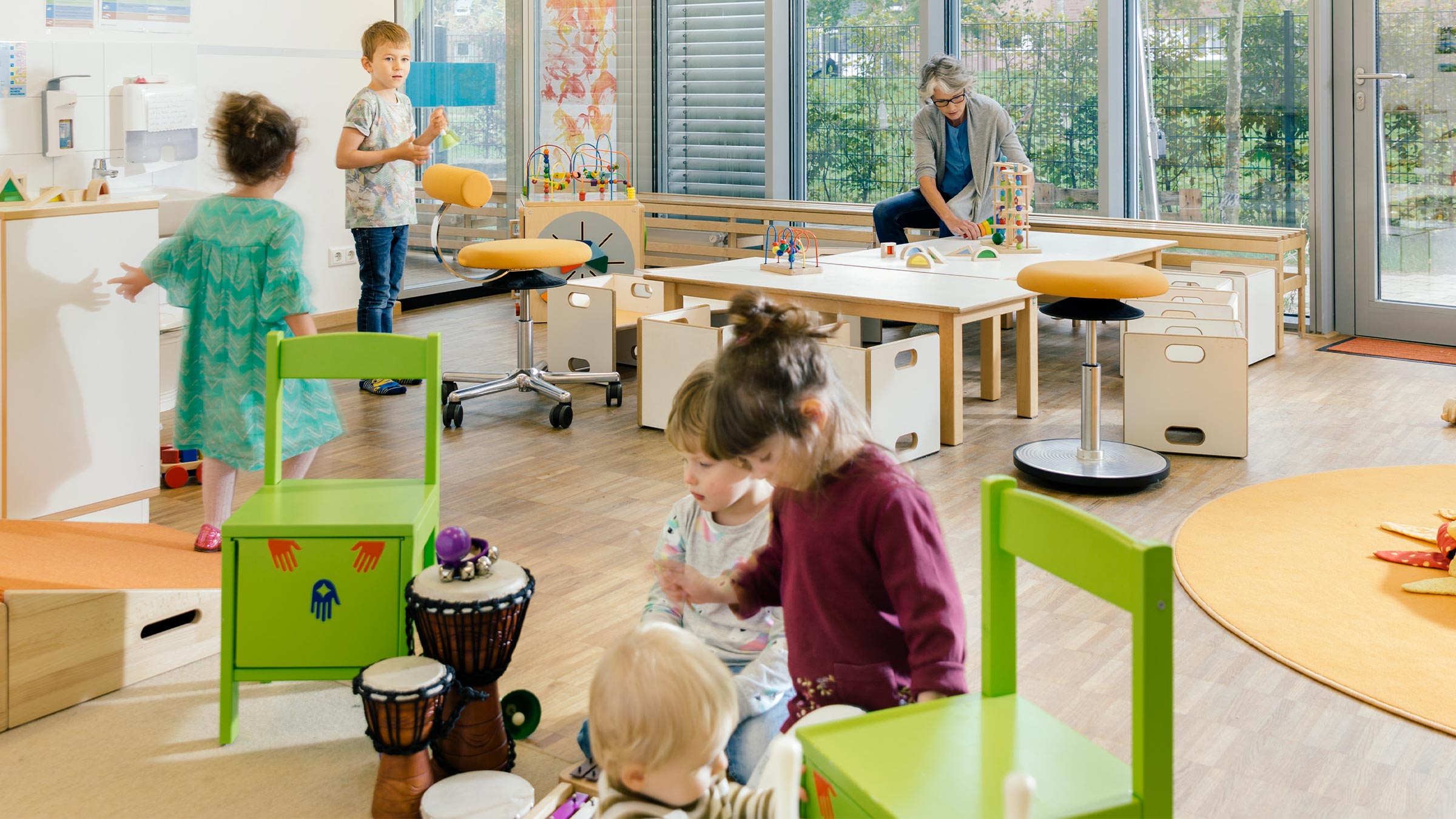The pressure on the child care industry appears to have eased a bit in 2023 from recent years even though business conditions remained very challenging, according to a recent Minneapolis Fed survey.
“I feel I am in a good place at the moment and am researching how to expand in order to meet the demand families are showing for my program,” a Twin Cities family child care provider said in the survey.
Like a growing number of providers, she reported that her business was doing better than the year before.
More than 1,200 providers throughout the state took part in the survey conducted by the Minneapolis Fed and First Children’s Finance in the first half of March 2024. The survey has been conducted each year since 2021.
Child care businesses in Minnesota and around the country have long struggled with high expenses and families’ inability to afford tuition that would allow providers to earn profits many other businesses earn. As a result, many providers and their employees struggle financially.
That didn’t change drastically in 2023, but compared with earlier years when the pandemic was in full swing, fewer respondents reported cash flow issues. Falling enrollment and rapidly rising expenses was less of a challenge for the industry. Many providers said new, larger state grants made a big difference.
But the business model providers relied on continues to change. Preschoolers and older children, the most profitable age groups for child care businesses, were increasingly cared for by parents working from home or by early learning programs at public schools. Many providers said their business became more dependent on the care of infants and toddlers, the least profitable age groups.
Fewer report falling enrollment
By many measures, the business environment improved for child care providers over the past year.
Although 29 percent of providers reported their enrollment fell year over year in 2023, that share was smaller than in the three previous years (Figure 1). Most types of child care programs throughout the state followed this trend. The exception was Twin Cities child care centers, with more providers reporting falling enrollment than in past years.
Child care centers are relatively large commercial facilities that typically care for dozens of children. Family child care providers typically care for a dozen or so children in the provider’s home. The survey also included a small number of other providers, such as preschool and Head Start programs.
But year-over-year comparisons don’t tell the whole story. Survey results suggest that there was quite a bit of churn. Around 60 percent of family providers and 95 percent of centers reported that families had left them during the year.
The top reason parents withdrew children from family providers was to enroll the children in school-based care programs, such as voluntary prekindergarten. Twin Cities providers were more affected by this, reflecting a higher concentration of school-based programs in the region.
“Four-year-olds are leaving for free preschool despite the fact that we offer a preschool curriculum in daycare to prepare them for kindergarten,” one Twin Cities family provider said. “All of my kids are more than ready for kindergarten when they stay until 5, but there is no comparison to free.”
For centers, the top reasons parents withdrew their children was not being able to afford tuition or families moving away.
“In order for us to increase employee wages we need to continue to raise the rates to our customers,” said the operator of a central Minnesota child care center. “Every time we raise rates, we lose a few customers because they can no longer afford childcare costs.”
In some cases, families enrolled part time to save on tuition and asked family or friends to fill in the gaps, providers said. In the Twin Cities, many centers also reported that families left after parents quit jobs to care for children or work from home.
Expenses soared, but not quite as high
Expenses also grew for many in 2023 (Figure 2). For example, 83 percent of family child care providers and 46 percent of child care centers said food costs increased significantly. Family providers felt the most pain because food is one of their top expenses.
“My food costs went from $1,100 a month to $2,300 a month,” a northwest Minnesota family provider said. “Supplies and [other expenses] increased to the point where we are now in a debt management company to make ends meet.”
But the share of providers reporting significant expense increases was actually lower than in prior years. In 2022, when inflation peaked, 90 percent of family providers and 79 percent of centers said food costs had increased significantly.
For centers, payroll expenses increased significantly for a vast majority of Twin Cities providers and for close to half of Greater Minnesota providers.
“We have had to increase pay higher than we can really afford because we found that no one would take a job offer for less than $20 to $22 dollars an hour,” said the operator of a Twin Cities center. “Some of our current teachers were just making that much, and they have been with us for 20-plus years. We are trying to be competitive with pay, but it is difficult to do without increasing tuition costs for families.”
Despite the financial burden, the share of centers that said they can sustain these cost increases long term has increased dramatically since 2022. That year, just 10 percent of centers thought wages and other incentives were sustainable. In the 2024 survey, 46 percent thought the incentives were sustainable.
That increase may be because of the state’s new Great Start grant program, which subsidizes teacher pay and certain other expenses. The grants are larger than the federal grant they replaced and do not have an expiration date. At $375 per month per full-time employee or equivalent, a grant is worth 12 to 15 percent of the average child care worker’s wage in Minnesota. Around 90 percent of providers reported receiving the grants.
“The only way we are able to sustain the wages right now is due to the Great Start Compensation Grants,” said the operator of a central Minnesota center, echoing many other providers.
Fewer providers squeezed financially
While fewer providers reported financial challenges compared with other years, progress has been uneven.
The share of providers who reported that losses from their child care business in 2023 had impacted their household income has fallen significantly since the height of the pandemic (Figure 3). But 2023 was only a slight improvement over 2022.
Most of the improvements were among Twin Cities providers, especially centers. In Greater Minnesota, the share of providers reporting impact on household income increased between 2022 and 2023.
“We have had to rely heavily on credit cards since mid-2022. ... We have cut out traveling, vacations, eating out, and had to switch our children to cheaper sports or school-funded extracurricular [activities],” said a family provider from northwest Minnesota. "I still have young children at home and will be taking on a second job as soon as my youngest is done breastfeeding.”
Other indicators also suggest some limited improvements in providers’ financial situations. For example, the share of providers who reported not being able to pay themselves at times fell from 23 percent in the 2022 survey to 21 percent in the 2024 survey.
Changing child care market
The child care business continues to evolve, and not necessarily in ways favorable to providers.
In recent years, providers have reported skyrocketing demand for infant and toddler care and falling demand for preschool and school-age care. This is partly because older children are easier to care for and because parents, burdened by tuition costs, rely less on professional child care providers and more on informal caregivers.
Public schools also become an option as children age. Schools have offered preschool, prekindergarten, and before- and after-school programs since before the pandemic. But such programs have grown in number in recent years, especially in Greater Minnesota. Pricing can be competitive, and some programs are free to low-income families who otherwise might choose a child care business and use tuition subsidies from the state. Even without lower pricing, parents may also be drawn to schools because they feel their children would get a better education or they already have older children in school.
Many providers said they have found themselves competing with their local schools.
“They take most my desired age group leaving only infants and toddlers looking for care,” a northeast Minnesota family provider said. “And since we are limited on the number of infants and toddlers, it impacts my income and will eventually put me out of business altogether.”
Family providers are limited in the number of younger children they can care for. For example, under the most common license for these providers, the maximum capacity is 10 children, but only three of them can be younger than 2. The majority of their capacity has to be filled by older children. Child care centers desire older children as well because they require fewer teachers, resulting in more profit.
Many providers said the state has allowed them a variance to care for slightly more younger children, but many others called for an overhaul of the student-teacher ratio.
Optimism in a time of crisis
Despite the challenges providers face, about half said they were optimistic about the future of the child care industry; another quarter were neutral. Twin Cities child care centers were the most optimistic while Greater Minnesota family providers were the least (Figure 4).
Still, an overwhelming 81 percent of providers said the industry is in crisis.
Many providers said they barely made ends meet, describing sacrifices such as vacations not taken, and cheaper, less healthy, food for themselves compared with the children in their care.
“We (self and partner) are not thriving financially,” said the owner of a central Minnesota center. “We are older and coming within retirement age. ... As business owners we worked hard to pay down all personal [expenses] in case we fall on ‘tough times.’ Here we are: tough times. We currently stopped contributing to retirement. Our families and staff depend on us to stay open.”
But many felt state policy was on the right track. Asked if they agreed the state is making investments that increase “the sustainability of child care businesses,” 46 percent said they agreed and 28 percent were neutral. Twin Cities centers again had the largest share of those who agreed at 72 percent while Greater Minnesota centers had the lowest at 38 percent.
But despite more state aid, many providers said it’s not enough. In some cases, grants allowed them to hold their ground financially but not grow. Others said they still struggled financially.
“The help that the state has provided has been incredibly helpful and without it, we would really be in trouble,” said the operator of a southeast Minnesota center. “However, there is still more help needed.”
Inflation continued to drive up expenses not just for her but for her families, she said. The state should give “more support to middle class families so that they can afford to pay the true cost of care. Right now, we can only charge what parents are able and willing to pay. That is not the true cost of care.”
Tu-Uyen Tran is the senior writer in the Minneapolis Fed’s Public Affairs department. He specializes in deeply reported, data-driven articles. Before joining the Bank in 2018, Tu-Uyen was an editor and reporter in Fargo, Grand Forks, and Seattle.






